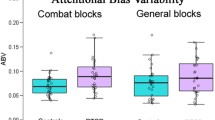Abstract
We examined the ability of Vietnam veterans with PTSD to focus attention on a primary digit detection task while concurrently viewing neutral or Vietnam-related picture and word distractors. Controlling for combat exposure, military service, and psychopathology, veterans with PTSD took longer to detect the target when Vietnam-related pictures were distractors. There were no reaction time differences when word stimuli were distractors. The latency effect was specific to trials with trauma-related pictures and did not spread to neutral trials interleaved within a mixed block of trauma and neutral pictures. Individuals with PTSD recalled proportionally more Vietnam-related words than other groups, implying differential attention to Vietnam-related words. Attending to trauma-related pictures interferes with performance of a concurrent task by individuals with PTSD.
Similar content being viewed by others
References
Cassiday, K. L., McNally, R. J., & Zeitlin, S. B. (1992). Cognitive processing of trauma cues in rape victims with post-traumatic stress disorder. Cognitive Therapy and Research, 16, 283–295.
Chemtob, C. M., Roitblat, H. L., Hamada, R. S., Carlson, J. G., Muraoka, M. Y., & Bauer, G. B. (1997). The Honolulu Post-Traumatic Stress Disorder stimulus set. Journal of Traumatic Stress, 10, 337–344.
Davidson, J. R. T., Kudler, H. S., Sanders, W. B., & Smith, R. D. (1990). Symptoms and comorbidity patterns in WWII and Vietnam veterans with post-traumatic stress disorder. Comprehensive Psychiatry, 31, 167–170.
Eckardt, M. J., Stapleton, J. M., Rawlings, R. R., Davis, E. Z., & Grodin, D. M. (1995). Neurological functioning in detoxified alcoholics between 18 and 35 years of age. American Journal of Psychiatry, 152, 53–58.
Foa, E. B., Feske, U., Murdock, T. B., Kozak, M. J., & McCarthy, P. R. (1991). Processing of threat-related information in rape victims. Journal of Abnormal Psychology, 100, 156–162.
Foa, E. B., & McNally, R. J. (1986). Sensitivity to feared stimuli in obsessive-compulsives: A dichotic listening analysis. Cognitive Therapy and Research, 10, 477–493.
Garner, W. R. (1970). The stimulus in information processing. American Psychologist, 25, 350–358.
Hope, D. A., Rapee, R. M., Heimberg, R. G., & Dombeck, M. J. (1990). Representations of the self in social phobia: Vulnerability to social threat. Cognitive Therapy and Research, 14, 477–485.
Just, M. A., & Carpenter, P. A. (1980). A theory of reading: From eye fixations to comprehension. Psychological Review, 87, 329–354.
Kaspi, S. P., McNally, R. J., & Amir, N. (1995). Cognitive processing of emotional information in posttraumatic stress disorder. Cognitive Therapy and Research, 19, 433–444.
Kazdin, A. E. (1992). Research design in clinical psychology. New York: Harper and Row.
Keane, T. M., Caddell, J. M., & Taylor, K. L. (1988). Mississippi scale for combat-related posttraumatic stress disorder: Three studies in reliability and validity. Journal of Consulting and Clinical Psychology, 56, 85–90.
Kulka, R. A., Schlenger, W. E., Fairbank, J. A., Hough, R. L., Jordan, B. K., Marmar, C. R., & Weiss, D. S. (1990). Trauma and the Vietnam War generation: Report of findings from the National Vietnam veterans readjustment study. New York: Bruner/Mazel.
Lavy, E. H., Oppen, P., & Hout, M. van den (1994). Selective processing of emotional information in obsessive-compulsive disorder. Behaviour Research and Therapy, 32, 243–246.
Litz, B. T., Weathers, F. W., Monaco, V., Herman, D. S., Wulfson, M., Marx, B., & Keane, T. M. (1996). Attention, arousal, and memory in posttraumatic stress disorder. Journal of Traumatic Stress, 9, 497–519.
Lund, M., Foy, D., Sipprelle, C., & Strachan, A. (1984). The combat exposure scale: A systematic assessment of trauma in the Vietnam war. Journal of Clinical Psychology, 40, 1323–1328.
Martin, M., Williams, R. M., & Clark, D. (1991). Does anxiety lead to selective processing of threat-related information? Behaviour Research and Therapy, 29, 147–160.
Mathews, A. M., & MacLeod, C. (1994). Cognitive approaches to emotion and emotional disorders. Annual Review of Psychology, 45, 25–50.
McNally, R. J., Amir, N., & Lipke, H. J. (1996). Subliminal processing of threat cues in posttraumatic stress disorder? Journal of Anxiety Disorders, 10, 115–128.
McNally, R. J., Amir, N., Louro, C. E., Lukach, B. M., Riemann, B. C., & Calamari, J. E. (1994). Cognitive processing of idiographic emotional information in panic disorder. Behaviour Research and Therapy, 32, 119–122.
Nelson, E. B., Sax, K. W., & Strakowski, S. M. (1998). Attentional performance in patients with psychotic and nonpsychotic major depression and schizophrenia. American Journal of Psychiatry 155, 137–139.
Schneider, W., & Shiffrin, R. (1977). Controlled and automatic human information processing: I. Detection, search, and attention. Psychological Review, 84, 1–66.
Shiffrin, R., & Schneider, W. (1977). Controlled and automatic human information processing: II. Perceptual learning, automatic attending, and a general theory. Psychological Review, 84, 127–190.
Spitzer, R. L., Williams, J. B. W., Gibbon, M., & First, M. B. (1989). Structured Clinical Interview for DSM-III-R (SCID-II,9/1/89 Version). New York, NY: New York State Psychiatric Institute.
Trandel, D. V., & McNally, R. J. (1987). Perception of threat cues in post-traumatic stress disorder: Semantic processing without awareness? Behaviour Research and Therapy, 25, 469–476.
Vrana, S. R., Roodman, A., & Beckham, J. C. (1995). Selective processing of trauma-relevant words in posttraumatic stress disorder. Journal of Anxiety Disorders, 9, 515–530.
Watts, F. N., McKenna, F. P., Sharrock, R., & Trezise, L. (1986). Colour naming of phobia-related words. British Journal Psychology, 77, 97–108.
Williams, J. M. G., Mathews, A., & MacLeod, C. (1996). The emotional Stroop task and psychopathology. Psychological Bulletin, 120, 3–24.
Yarbus, A. L. (1965). Eye movements and vision (Translated by Riggs, L. A.). New York: Plenum Press.
Author information
Authors and Affiliations
About this article
Cite this article
Chemtob, C.M., Roitblat, H.L., Hamada, R.S. et al. Compelled Attention: The Effects of Viewing Trauma-Related Stimuli on Concurrent Task Performance in Posttraumatic Stress Disorder. J Trauma Stress 12, 309–326 (1999). https://doi.org/10.1023/A:1024728626505
Issue Date:
DOI: https://doi.org/10.1023/A:1024728626505




